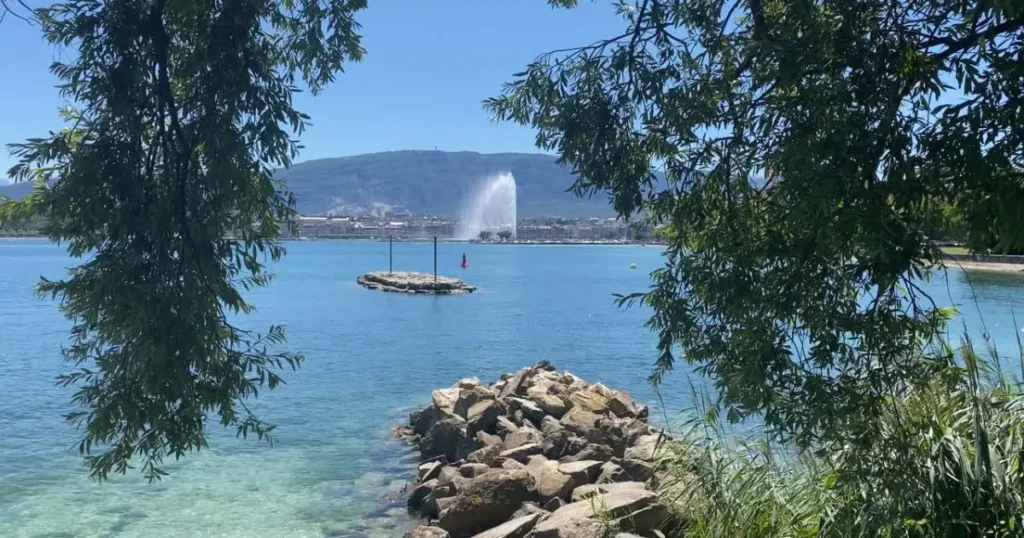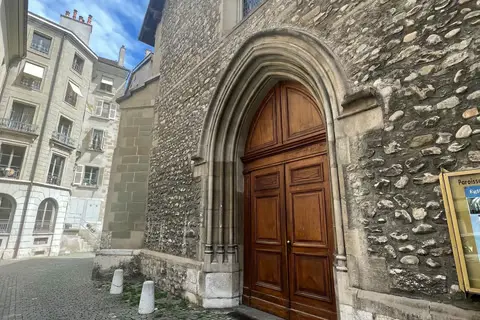Geneva’s Jet d’Eau has majestically graced Lake Geneva for over a century, shooting its column of water 140 meters into the sky. Yet this iconic symbol of the city began as nothing more than an industrial accident. The transformation from a simple safety valve to a world-renowned tourist attraction reveals the pragmatic and aesthetic spirit of Geneva’s residents.
From Industrial Accident to Icon (1886-1951)
The Industrial Origins (1886-1891)
The story begins in 1886 with the construction of the Coulouvrenière hydraulic plant. This industrial facility supplied pressurized water to the city’s craftsmen and watchmakers. However, an unexpected technical problem would give birth to Geneva’s future symbol.
Each evening when workshops closed, pressure in the network became excessive. To prevent damage to the pipes, engineers installed a safety valve that released this excess pressure. The result? A spectacular water jet that shot up near the plant, already reaching thirty meters in height.
What was designed as a purely technical solution quickly became a spectacle appreciated by Geneva’s residents. Strollers stopped to admire this unexpected phenomenon, and local press began taking interest.
Official Recognition and Relocation (1891)
Faced with popular enthusiasm, Geneva authorities decided to transform this industrial accident into a permanent attraction. In 1891, the Jet d’Eau was officially adopted as a decorative city element and moved to its current location at the tip of the Eaux-Vives jetty.
This relocation was strategic. Positioned on Lake Geneva, the fountain became visible from numerous points throughout the city and even from the French shore. Engineers took advantage of this move to improve the system, increasing the jet’s height to approximately 90 meters.
Modern Evolution (1951-Present)
A major modernization in 1951 definitively transformed Geneva’s Jet d’Eau. The new, more powerful system brought the jet to its current 140-meter height. This impressive technical performance requires pumps capable of projecting 500 liters of water per second at an exit velocity of approximately 200 km/h.
The installation of a lighting system in the 1950s made the fountain a nighttime spectacle as well. Originally fixed white lights, the system evolved to modern LED technology allowing colored illuminations for special events.
Best Viewing Spots: A Complete Guide
Eaux-Vives Jetty: The Immersive Experience
The Eaux-Vives jetty offers the most spectacular approach to Geneva’s Jet d’Eau. This 300-meter promenade leads directly to the fountain’s base, providing a unique sensory experience. The sound of water, spray that falls according to wind direction, and visible power of the mechanism create a striking impression.
Caution: In favorable wind conditions, spray can reach several dozen meters. Protect electronic devices and dress accordingly.
English Garden: Classic Views and Rainbows
The English Garden provides the classic postcard view of Geneva’s Jet d’Eau. From this slightly elevated position, you can embrace the entire spectacle: the jet in its lakeside context, with the Alps as backdrop on clear days.
This is also one of the best spots to photograph rainbows forming in water droplets. The phenomenon is particularly visible in late afternoon when the sun descends toward the horizon.
Mont-Blanc Bridge: Urban Perspective
The Mont-Blanc Bridge offers a unique perspective, integrating the Jet d’Eau into Geneva’s urban landscape. This elevated view allows appreciation of the jet’s real height relative to surrounding buildings and understanding of its visual impact on the city’s skyline.
Bains des Pâquis: Authentic Local Atmosphere
The Bains des Pâquis provide a more relaxed approach to fountain observation. This Geneva institution, with its friendly refreshment stand, allows contemplation of the spectacle while enjoying a hot drink or typically Swiss meal.
Technical Marvel: Engineering Excellence
Performance and Specifications
Geneva’s Jet d’Eau represents a permanent technical challenge. Its 140-meter height makes it one of the world’s highest water jets, maintained by a sophisticated pumping system located in an underwater station.
The figures are impressive: 500 liters of water per second propelled at 200 km/h at the nozzle exit. This phenomenal speed explains why water disperses into fine droplets creating the characteristic mist effect visible from afar.
Safety and Maintenance Systems
The fountain features sophisticated automatic safety systems. Weather sensors continuously monitor wind and temperature conditions. In winds exceeding 23 km/h or sub-zero temperatures, the system automatically shuts down to avoid danger to pedestrians and preserve equipment.
Regular maintenance requires professional divers to inspect underwater installations. These operations, conducted several times yearly, guarantee optimal system functioning.
Special Illuminations: When the Fountain Shows Its Colors
Since modernization, Geneva’s Jet d’Eau lighting system can produce a wide range of colors. Twelve high-power LED projectors installed on the jetty illuminate the water column after sunset.
The fountain regularly transforms into visual communication support, with colored lighting marking:
- World Cancer Day (purple)
- International Human Rights Day (UN blue)
- Swiss national celebrations (red and white)
- Environmental awareness (green)
- International sporting events (team or country colors)
Tourism Impact and Cultural Significance
Geneva’s Jet d’Eau attracts several million visitors annually, making it one of Switzerland’s most photographed tourist attractions. This popularity generates significant economic impact for the Geneva region.
Beyond tourism, the fountain has become a strong identity element for Geneva, appearing on numerous city communications from postcards to official logos. This identification is so strong that the Jet d’Eau now ranks among the most internationally recognizable Swiss symbols.
Practical Visiting Tips
Best Photography Moments
Late afternoon light, one to two hours before sunset, offers ideal conditions for photographing Geneva’s Jet d’Eau. This “golden hour” softens contrasts and captures water mist details.
For rainbows, position yourself with the sun behind you and wait for spray to create sufficient suspended droplets. Conditions after a shower are often perfect.
Transportation and Access
The fountain is easily accessible by Geneva public transport. Bus lines 1, 25, and E stop near the Eaux-Vives jetty. From Cornavin station, allow about 10 minutes by public transport or a pleasant 20-minute walk along the lake.
Suggested Walking Circuit
An optimal circuit begins at the English Garden for initial visual approach, continues on Mont-Blanc Bridge for urban perspective, descends to Eaux-Vives jetty for immersive experience, and ends at Bains des Pâquis for a well-deserved break.
This 2-3 kilometer loop can be comfortably covered in one hour, longer if you take time to photograph and observe.
Frequently Asked Questions
Why does the fountain sometimes stop? The automatic safety system stops the jet in strong winds (over 23 km/h) or freezing conditions to protect pedestrians and preserve equipment.
How high does it actually reach? The official height is 140 meters, though it may vary slightly depending on atmospheric conditions and water pressure.
Does it operate year-round? Yes, except during scheduled maintenance or unfavorable weather conditions. It’s typically shut down for a few weeks annually for servicing.
Geneva’s Jet d’Eau continues evolving while preserving its emblematic character. This technical marvel, born from an industrial accident, perfectly illustrates Geneva’s capacity to transform utility into beauty, creating a lasting symbol that unites residents and visitors around a daily natural spectacle.
To discover more about Geneva’s rich cultural heritage, explore the fascinating history of Swiss watchmaking in the city.


